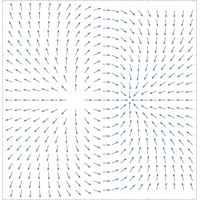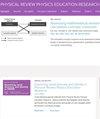场的向量表示和单位向量表示:理解问题和可行的教学策略
IF 3.6
2区 教育学
Q1 EDUCATION & EDUCATIONAL RESEARCH
Physical Review Physics Education Research
Pub Date : 2024-06-05
DOI:10.1103/physrevphyseducres.20.010150
引用次数: 0
摘要
矢量场是一个高度抽象的物理概念,通常采用可视化的方式进行教学。虽然矢量表示法特别适用于定量数据的可视化,但由于矢量箭头可能会重叠,因此经常令人困惑,尤其是在描述磁场和电场等实际场时。本研究调查了中学教育结束时对矢量的理解。特别是,研究了在多大程度上可以从传统的单位矢量表示法和带有居中单位矢量的表示法中推导出场的几何形状。为了支持这种理解,我们对两种练习进行了比较。非线性练习在传统单位矢量表示法的范围内进行论证,而多重表示法练习则试图支持居中单位矢量和传统单位矢量之间的联系。结果表明,几乎所有受测者都正确地解决了生成向量表象的题目,但在解释向量表象时却遇到了很大的困难。因此,绘制矢量图和解释矢量图似乎是两种不同的技能,应该以综合的方式进行强化练习。在解释向量表象时,可以发现各种问题。例如,矢量的数量经常被错误地用来估计场的强度,尽管每个表面元素的矢量越多,实际上只会提高表征的分辨率。然而,这里的结果表明,学习者对绘制矢量的纵向密度和横向密度的感知是不同的。此外,与传统的单位矢量相比,学习者更容易从居中的单位矢量中识别出实地的几何形状。特别是在解释旋转磁场和同时包含源和汇的磁场的常规单位向量几何图形时,会出现错误,而解释只包含汇的磁场的几何图形时则相当好。对两种训练练习的比较表明,加深学生理解的一种可行方法是使用一种练习,对比传统的和居中的单位矢量表示法,并解释如何从一种表示法转换到另一种表示法,而不是只描述一种表示法的主要元素。最后,根据研究结果,我们提出了在学校教授矢量表示法的策略。鉴于居中单位矢量表示法的可读性明显提高,研究结果甚至提出了这样一个问题:这种表示法将来是否有可能取代教科书和学习材料中的传统表示法。本文章由计算机程序翻译,如有差异,请以英文原文为准。

Vector representations and unit vector representations of fields: Problems of understanding and possible teaching strategies
Vector fields are a highly abstract physical concept that is often taught using visualizations. Although vector representations are particularly suitable for visualizing quantitative data, they are often confusing, especially when describing real fields such as magnetic and electric fields, as the vector arrows can overlap. The present study investigates vector understanding at the end of secondary education. In particular, the extent to which the geometry of the field can be derived from conventional unit vector representations and representations with centered unit vectors was examined. To support this understanding, two exercises were compared. The unirepresentational exercise argued within the conventional unit vector representation, while the multirepresentational exercise attempted to support the link between centered and conventional unit vectors. The results show that almost all test subjects solved the items for generating vector representations correctly, but significant difficulties were encountered in interpreting vector representations. Drawing and interpreting vector representations therefore appear to be different skills that should be practiced intensively and in an integrated way. Various problems could be identified when interpreting vector representations. For example, the number of vectors is often erroneously used to estimate the strength of the field, although more vectors per surface element actually only increase the resolution of the representation. Here, however, the results suggest that the longitudinal density and the transverse density of the drawn vectors are perceived differently by the learners. Furthermore, the learners recognized the field’s geometry much more readily from centered unit vectors than from conventional unit vectors. Errors occur especially when interpreting the geometry of conventional unit vector representations of rotational fields and fields containing both sources and sinks while the geometries of fields containing only sinks were interpreted quite well. The comparison between the two training exercises showed that a promising approach to deepen students’ understanding would be to use an exercise that contrasts conventional and centered unit vector representations and explains how to translate from one representation to the other, rather than describing the main elements of only a single representation. Finally, based on the results of the study, we propose a strategy for teaching vector representations in schools. Given the significantly improved readability of the representation with centered unit vectors, the results even raise the question of whether this type of representation could possibly replace the conventional representation in textbooks and learning materials in the future.
求助全文
通过发布文献求助,成功后即可免费获取论文全文。
去求助
来源期刊

Physical Review Physics Education Research
Social Sciences-Education
CiteScore
5.70
自引率
41.90%
发文量
84
审稿时长
32 weeks
期刊介绍:
PRPER covers all educational levels, from elementary through graduate education. All topics in experimental and theoretical physics education research are accepted, including, but not limited to:
Educational policy
Instructional strategies, and materials development
Research methodology
Epistemology, attitudes, and beliefs
Learning environment
Scientific reasoning and problem solving
Diversity and inclusion
Learning theory
Student participation
Faculty and teacher professional development
 求助内容:
求助内容: 应助结果提醒方式:
应助结果提醒方式:


